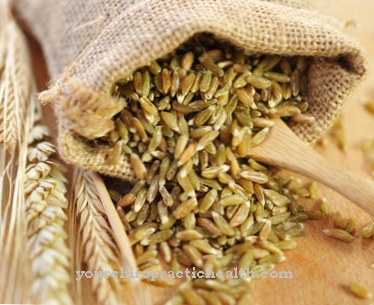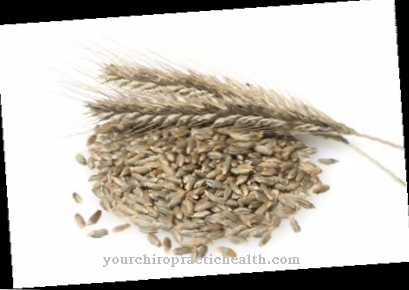The coconut has been very popular for thousands of years due to its delicious taste and positive properties. It belongs to the palm family. Botanically, the coconut does not belong to the nuts, but to the stone fruits.
What you should know about the coconut

The coconut palms on which the coconuts grow are more than 20 meters high. The tree, which can live to be 120 years old, bears fruit all year round in various stages of development, so that coconuts are constantly ripening and the coconuts can be bought all year round.
A palm tree provides around 30 to 40 fruits per year. The main coconut growing countries are, for example, Indonesia, India, the Philippines and Brazil. The coconuts available in Germany are only the inner part, which is surrounded by some bast threads. The outer layers are already removed in the growing countries. The coconut consists of a green, yellow or light brown thin and leather-like shell and a dry, thick and fibrous underlayer. The entire coconut can weigh two kilograms.
The skin, the white pulp and the coconut water in the inner cavity are located under the very hard shell.
There is a lot of it, especially in the unripe coconuts, which are around seven months old. The coconut water has a slightly sweet and sour taste that is refreshing. With increasing ripeness, the coconut water then forms the pulp, which solidifies and becomes woody during the process. The white pulp tastes very aromatic and is one to two centimeters thick. Although the coconut botanically belongs to the stone fruits and not to the nuts, the white pulp actually tastes like a nut. The coconut water, on the other hand, which is inside the coconut, has a sweetish and at the same time slightly sour taste.
Importance to health
Most of the vegetable fats contained in coconuts are short-chain acids that are very easy to digest. The fatty acids in coconut oil can prevent numerous diseases, for example of the circulatory system and metabolism.
They also provide the body with quick energy, but are rarely stored in the fat deposits. In addition, there is no bad cholesterol in the oil of the coconut, which is held responsible for arteriosclerosis. On the contrary, because the proportion of healthy cholesterol (HDL) is high in the oil. This is supposed to protect the heart and the arteries from calcification. The brain function should also be improved. Just one portion of the fresh pulp provides more than 15 percent of the daily copper requirement. This trace element activates enzymes which ensure that neurotransmitters are formed.
These transmit information from one cell to another. This holds out the promise of reducing diseases like Alzheimer's. The coconut milk is also said to help with acne and regulate an underactive thyroid. The coconut is also said to be healthy for diabetics, as it is believed that the medium-length fatty acids reduce insulin resistance. In addition, the pancreas is stimulated to produce more insulin.
Ingredients & nutritional values
| Nutritional information | Amount per 100 gram |
| Calories 354 | Fat content 33 g |
| cholesterol 0 mg | sodium 20 mg |
| potassium 356 mg | carbohydrates 15 g |
| protein 3.3 g | Fiber 9 g |
The coconut is an integral part of the diet in its countries of origin, which is due to the valuable ingredients. The essential linoleic acid it contains, which the body cannot produce itself and therefore has to be supplied through food, is also beneficial. 100 grams of coconut contain around 350 calories and 35 grams of fat. In addition to water, stone fruit also contains protein, fiber, sugar, calcium, potassium, selenium, phosphorus, sodium, magnesium and vitamins C, E and B.
Intolerances & allergies
The coconut is easy to digest after the waiting period. It is one of the low-fructose types of fruit, so that it is mostly suitable for people with an intolerance. However, not too much of the coconut should be eaten at once to avoid problems. Since the coconut contains plenty of vegetable fat, it should be consumed in moderation, especially during a diet.
Shopping & kitchen tips
When buying the coconut, care should be taken to ensure that it is fresh. This can be checked using the shake test: if it gurgles audibly, the coconut is usually in an optimal condition. The fresher the stone fruit, the more coconut water it contains.
If the nuts are dried out, the pulp tastes soapy, making it inedible. The fresh coconut will keep for two to three weeks in the vegetable compartment of the refrigerator. Since the pulp is very filling, the entire coconut often cannot be consumed at once. Leftovers from an opened nut can be placed in a bowl, filled with enough water to cover the coconut pieces. The bowl can then be placed in the refrigerator and the coconut can be consumed within the next two to three days.
However, the water is changed at least once a day. Many people shy away from preparation, although cracking the rock-hard fruit is not that difficult with a little practice. A hard and pointed object is required for this, for example a screwdriver, a hammer and a sharp knife. Use the screwdriver to enlarge the two so-called "eyes" that have grown up so that the coconut water can run off. Now hit the center of the coconut shell all around with the hammer until a crack forms. The coconut can be easily broken along this. It is now possible to detach the pulp from the two halves with a knife.
Preparation tips
In the countries where the coconut is grown, it is offered chilled as a soft drink. The nut itself serves as a vessel. This also makes it possible to get to the pulp. This can be scraped out with a spoon. Fresh meat tastes good on its own as a nibble, but also in the grated or diced form it enriches fruit salads, creams, puddings, cakes, tarts and ice cream, making the dishes not only delicious but also healthy.
Even hearty dishes are perfectly complemented with the coconut, because meat, fish and vegetables can be breaded with desiccated coconut. An exotic vegetable and rice pan and a wonderfully creamy pumpkin seed soup are popular classics.Of course, coconut milk should not be missing with the aromatic curry. Incidentally, coconut milk is a good substitute for people who cannot digest cow's milk.
It also ideally complements vegan cuisine. The popular coconut milk is made by pureeing the meat of the coconut with water and then squeezing it. The coconut water is also often the basis for delicious cocktails or sauces. Who doesn't feel that South Sea feeling with this thought alone? Copra is the dried pulp. From this coconut fat, oil, flakes and paste are obtained.
















.jpg)
.jpg)



.jpg)






